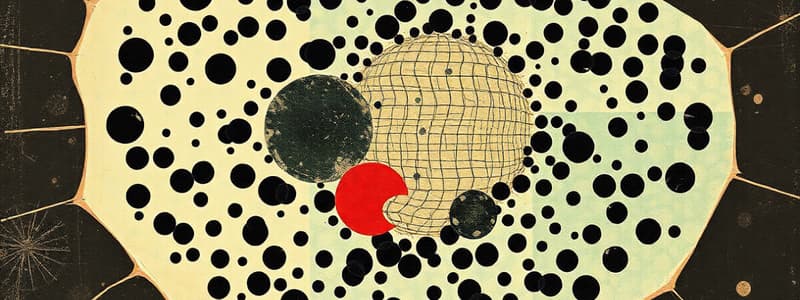Podcast
Questions and Answers
What would best describe a prokaryotic cell?
What would best describe a prokaryotic cell?
- It is always multicellular.
- It is the smallest unit capable of performing life functions.
- It has a membrane-bound nucleus and organelles.
- It lacks a membrane-bound nucleus and organelles. (correct)
Who was the first to use the term 'cell'?
Who was the first to use the term 'cell'?
- Robert Hooke (correct)
- Anton van Leeuwenhoek
- Mathias Schleiden
- Thomas Schwann
Which of the following statements is NOT part of the Cell Theory?
Which of the following statements is NOT part of the Cell Theory?
- All cells can perform photosynthesis. (correct)
- Cells are the smallest working units of all living things.
- All cells come from pre-existing cells through cell division.
- All living things are composed of one or more cells.
Which structure is only found in eukaryotic cells?
Which structure is only found in eukaryotic cells?
What conclusion did Mathias Schleiden reach regarding plant cells?
What conclusion did Mathias Schleiden reach regarding plant cells?
What is the primary function of the mitochondria in a cell?
What is the primary function of the mitochondria in a cell?
Which organelle is responsible for packaging proteins and preparing them for export?
Which organelle is responsible for packaging proteins and preparing them for export?
What role do lysosomes play in a cell?
What role do lysosomes play in a cell?
What is the primary function of the vacuole in plant cells?
What is the primary function of the vacuole in plant cells?
Which structure is essential for movement of substances past the cell membrane and also aids locomotion?
Which structure is essential for movement of substances past the cell membrane and also aids locomotion?
What distinct feature do centrioles have in animal cells?
What distinct feature do centrioles have in animal cells?
Which part of a plant cell is responsible for producing sugars and oxygen gas during photosynthesis?
Which part of a plant cell is responsible for producing sugars and oxygen gas during photosynthesis?
What is a primary role of the cytoskeleton in the cell?
What is a primary role of the cytoskeleton in the cell?
What is the primary function of the cell wall in plant cells?
What is the primary function of the cell wall in plant cells?
Which of the following structures is responsible for making ribosomes?
Which of the following structures is responsible for making ribosomes?
What separates the nucleus from the cytoplasm?
What separates the nucleus from the cytoplasm?
Which organelle is involved in the internal delivery system of the cell?
Which organelle is involved in the internal delivery system of the cell?
In what state is DNA found within chromatin?
In what state is DNA found within chromatin?
Where are ribosomes primarily located?
Where are ribosomes primarily located?
What is the primary role of the cell or plasma membrane?
What is the primary role of the cell or plasma membrane?
Which component of prokaryotic cells contains the chromosomal DNA?
Which component of prokaryotic cells contains the chromosomal DNA?
Flashcards are hidden until you start studying
Study Notes
Overview of Cells
- Cells are the smallest units capable of performing life functions.
- Organisms can be unicellular (one cell) or multicellular (many cells).
- Types of cells: Prokaryotic (no nucleus, no organelles, e.g., bacteria) and Eukaryotic (have a nucleus and organelles, e.g., plants, animals).
Historical Discoveries
- Anton van Leeuwenhoek first observed living cells in the 1600s using a simple microscope.
- Robert Hooke utilized a compound microscope to view cork and coined the term “cell”.
- Mathias Schleiden and Thomas Schwann concluded that all plants and animals, respectively, are composed of cells in the 1830s.
Cell Theory
- All living things are made up of one or more cells.
- Cells are the smallest working units of living things.
- All cells arise from pre-existing cells through cell division.
Microscopy
- Compound microscopes magnify objects through a series of lenses.
- The evolution of microscopy has been pivotal in understanding cell structure and function.
Prokaryotic Cells
- First cells to evolve, lacking membrane-bound organelles and a nucleus.
- Genetic material is freely located in the cytoplasm as a singular circular chromosome.
- Ribosomes are the only notable structures.
Eukaryotic Cells
- Two major types: Plant cells and Animal cells.
Key Cell Structures
- Cell Wall: Present in plant cells and bacteria; composed of cellulose for protection and support.
- Cell/Plasma Membrane: Outer layer regulating substance movement; double-layered (bi-layer).
- Cytoplasm: Gel-like substance where organelles are suspended; site of chemical reactions.
- Nucleus: Control center containing DNA; separated from cytoplasm by the nuclear membrane.
Organelles and Their Functions
- Nuclear Membrane: Encloses the nucleus, made of two layers with pores for material exchange.
- Chromatin: DNA in a non-dividing state, providing genetic instructions.
- Nucleolus: Dark structure in the nucleus responsible for ribosome production.
- Rough Endoplasmic Reticulum (RER): Ribosome-studded network transporting and processing proteins.
- Smooth Endoplasmic Reticulum (SER): Lacks ribosomes; involved in lipid production and detoxification.
- Golgi Apparatus: Modifies, sorts, and packages proteins and lipids for export.
- Lysosomes: Contain digestive enzymes; break down waste, recycling cellular components.
- Mitochondria: Powerhouses of the cell, generating ATP through cellular respiration; more abundant in active cells.
- Animal Vacuole: Storage sacs involved in digestion and waste removal.
- Plant Vacuole: Large central vacuole for water and nutrient storage; maintains cell shape.
- Chloroplasts: Found in plant cells, site of photosynthesis, converting sunlight into energy.
- Cilia and Flagella: Structures aiding in movement; cilia also move substances across membranes.
- Centrioles: Animal cell structures aiding in organizing cell division.
- Cytoskeleton: Composed of microtubules and filaments; maintains cell shape and facilitates movement.
Studying That Suits You
Use AI to generate personalized quizzes and flashcards to suit your learning preferences.



